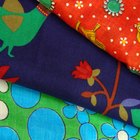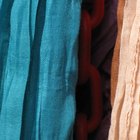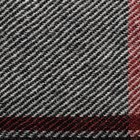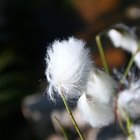
Cashmere is a high-quality fiber that is very valuable in the world of textiles. From this luxurious fiber, a multitude of beautiful garments can be made. The unique properties of this material make it a highly sought-after commodity and a booming industry in the countries of Turkey, Iraq, Iran, Afghanistan, Kashmir, New Zealand and Australia. Goats from which cashmere is harvested are easy to raise and can survive on very little amounts of a variety of native food sources.
Color
Raw cashmere comes naturally from the goat in only the three colors of white, gray and brown. Through spinning, dyeing, knitting and weaving the fiber into yarn, a multitude of beautiful colors can be achieved. Such cashmere yarns can then be made into a garment of any color or pattern desired.
Fineness
The rough wool taken from the goats endures a long process of hand selection, washing and combing. The result is a raw cashmere fiber that is free of coarse hair, skin scraps, oil and other natural content. After this process the fineness of each strand of cashmere is typically between 7 and 19 microns with an average of 14 microns as an industry standard. This fineness gives cashmere its trademark silky texture.
Physical Properties
Cashmere fibers are cylindrical, soft, silky, smooth, resilient, moisture-absorbing and very warm. Cashmere has a very soft and warm natural luster that resembles wool more so than any other hair fiber.
Wearability
Cashmere doesn't stand up to hard wear because of its very delicate downy nature. To maintain a quality garment, cashmere shouldn't be worn for an extended time. Giving the fibers rest lets them avoid fatigue and recover their natural elasticity. Pilling can be avoided by ensuring that the material isn't subjected to any long-term rubbing or friction against another garment or surface.
Washing
Hand-washing is the only acceptable form of at-home laundering for cashmere. A detergent intended for fine garments should be used in lukewarm to cool water. Soak the cashmere garment for 20 minutes, gently distributing the sudsy water throughout. Drain the sink and run clean cool water through the garment until the water rinses clear and the cashmere is free of residual soap. Gently press out water and lay the garment flat on a clean white towel. Roll the towel and press gingerly to allow absorption of excess water. Gently remove the cashmere from the towel and smooth back into original shape. The cleaned cashmere garment can then be placed on a clean dry towel or drying rack until totally dry.
Related Articles

What Is Arnel Vintage Material Fabric?

What Is Superfine Wool?

Cashmere Vs. Viscose

Denim vs. Denim Blends

Fake Vs. Real Pashmina

How to Care for Merino Wool

Care Instructions for Voile Fabric

What Types of Fabrics Absorb Dye Best?

How to Protect Cashmere Scarves From ...

How to Whiten Cashmere & Woolen ...

Care of Mohair Fabric

Can You Hand Wash Silk That Says Dry ...

Types of Wool Sweaters

How to Stretch a Rayon Sweater

How to Shrink Acrylic Sweaters

The Disadvantages of Silk

What Is Berber Fleece?

How to Clean Mohair

What Are Clothing Textures?

Rayon Spandex Care Instructions
References
Writer Bio
Christina Bush has been writing professionally since 1995. She is well-versed in multiple styles of writing, ranging from instructional to technical. Bush has been published in newspapers across the state of Ohio, including the "Columbus Dispatch," the "Ohio State Lantern" and "Toledo Press." Bush received her Bachelor of Arts in professional writing and Medieval literature from The Ohio State University in 2005.
Photo Credits
Jupiterimages/Photos.com/Getty Images